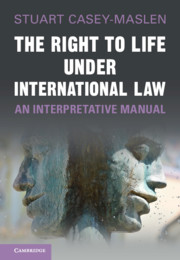
In recent years, there has been increasing movement towards envisaging the right to life not only in terms of human beings, but in terms of other mammals. In Argentina, in 2014, a Federal Chamber of Criminal Appeals ruled that animals hold fundamental rights, finding it ‘necessary’ to recognise a specific orangutan in a zoo as a subject of rights. In the United Kingdom, the sentient animals bill that originated in the House of Lords and which is currently before Parliament is one step on the road to formal recognition of the rights of at least certain animals to life and to freedom from inhumane treatment. More broadly, increased concern about climate change and our treatment of the planet has led to a panel of distinguished international lawyers to propose a new international crime of ecocide in June of this year. Is this perhaps a first step towards recognizing that the planet we inhabit also has a right to life?
Until now, the natural environment has been seen rather in terms of our right as individuals or peoples to a healthy environment, with associated prohibitions in peacetime and in armed conflict on wanton environmental damage. With respect to the former, in 2016, Colombia requested an Advisory Opinion from the Inter-American Court of Human Rights on State obligations in relation to the environment in the context of the protection and guarantee of the rights to life and to personal integrity. In response, the Court held that a person within the jurisdiction of the Pact of San José can bring a claim if a State Party’s actions have caused environmental damage that has resulted in violation of a fundamental human right. The Court further decreed that a State Party must cooperate in good faith with other States to prevent and address any risk of significant transnational environmental harm.
The link between human rights and the environment was first made in the 1972 Stockholm Declaration. As the Declaration made clear from the outset: ‘Both aspects of man’s environment, the natural and the man-made, are essential to his well-being and to the enjoyment of basic human rights – even the right to life itself’. In 1981, the Banjul Charter first set forth a treaty right of ‘all peoples’ in Africa to ‘a general satisfactory environment favourable to their development’. Although the European Convention on Human Rights does not contain an explicit right to a clean and quiet environment, the European Court of Human Rights, through its caselaw, has established that where an individual is directly and seriously affected by pollution, an issue may arise under the Convention. In November 2020, a climate change case was brought before the Court by six campaigners from Portugal.
In situations of armed conflict, deliberate modification of the environment for hostile purposes was prohibited by dedicated treaty in 1976. A year later, in the First Additional Protocol to the Geneva Conventions, it was prohibited to employ methods or means of warfare which are intended, or may be expected, to cause widespread, long-term and severe damage to the natural environment. As the International Committee of the Red Cross explained in its commentary on the provision, this is ‘a matter not only of protecting the natural environment against the use of weapons or techniques deliberately directed against it, nor merely of protecting the population and the combatants of the countries at war against any of these effects, but also one of protecting the natural environment itself’.
The prohibition on attacking the natural environment would later become a war crime falling within the jurisdiction of the International Criminal Court (though so far only in international armed conflicts). The offence involves the intentional launching of an attack in the knowledge that it will cause ‘widespread, long-term and severe damage to the natural environment’ that ‘would be clearly excessive in relation to the concrete and direct overall military advantage anticipated’.
All of which leads us to June of this year and the proposed new international crime of ‘ecocide’, applicable in peace as it is in time of armed conflict. The text put forward under the aegis of the Stop Ecocide Foundation defines ecocide as ‘unlawful or wanton acts committed with knowledge that there is a substantial likelihood of severe and widespread or long-term damage to the environment being caused by those acts’. It is thus broad in scope, clearly more extensive than the corresponding war crime, but the drafting has been well thought out (one would expect nothing less, given the close involvement of Philippe Sands, Kate Mackintosh, and Alex Whiting, among others).
We will see in time whether their efforts are rewarded by new law. Maybe one day we will even accept that we cannot continue to do to our planet what we have done in the last one hundred years; that its ‘right to life’ and ours are inextricably interlinked. For, ‘in the final analysis’, as President Kennedy famously recalled in June 1963, ‘our most basic common link is that we all inhabit this small planet. We all breathe the same air.’

Latest Comments
Have your say!